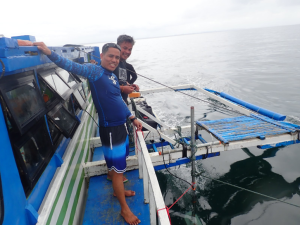Using sound to improve fishery management study sardines in the Philippines

By EDF’s Jose Ingles, Jimely Flores and Rod Fujita, and Joseph Warren, Stony Brook University
Small fish have a big role. Fisheries for sardine, herring and anchovy species collectively produce more yield than any other fisheries worldwide and account for about one-third of total global catches arriving in ports. These fisheries span the globe and are critical for supporting livelihoods, aquaculture, food security, ecotourism and terrestrial animal husbandry (many catches are used to make fishmeal and fish oil).
These species, known as coastal pelagics, are especially important in the Philippines, which is home to some of the highest fish biodiversity levels on the planet and an expanding population that depends on fish as a primary nutrition source. Between 2018 and 2022, the average sardine production topped 358 thousand tons. In addition to the nutritional and financial benefits, properly managed sardines provide stable livelihoods to many people and important ecosystem services.
Without the science to guide fishery management, fishers do not have the data to know when and where to fish in a sustainable way. An acoustic survey provides that data, using instruments to measure underwater sound and assist fishery managers as they gather information about what kind of fish are present — and how many there are.

Echosounder systems use sound waves to determine what is below the surface of the ocean by sending a short pulse of sound down through the water column. When that pulse encounters something, like fish, bubbles or the seafloor, it produces echoes, indicating where something is located — think fancy fish finder. Unlike the fish finders on recreational boats, this data can be recorded and calibrated so scientists can get a clearer picture of what is under the water.
Sardines are small, nearshore species that form large masses and contain an air bladder to regulate their buoyancy. Acoustic instruments detect this air bladder to visualize where the fish are located, how many are in the water column and the health of the fishery.
In the Philippines, more than 11 participants from the Philippine Bureau of Fisheries and Aquatic Resources (BFAR) and the Department of Environment and Natural Resources (DENR) joined EDF and Cornell University fisheries scientists to learn how to use this technology and conduct pilot studies across the region.
Over the course of two weeks, local boats and crews conducted echosounder surveys across the Ticao, Burias Pass Protected Seascape, the Gulf of Ragay and the North Samar in search of schooling sardines. Following a zig-zag pattern, acoustic equipment on two vessels simultaneously surveyed a total area of 641 km, uploading data in real-time to computers onboard each vessel.

This is just the beginning of this work in the Philippines. The goal of this study is to create an index for sardines in these areas. In fishery management, an index is a parameter that varies in a similar manner to biomass — so if the index increases over time, that likely means there are more fish in that region. This index is a vital part of fishery management, it provides a source of unbiased data to complement the catch data that is currently used to manage this important fishery. Before that can happen, though, researchers need to analyze and interpret the data. Over the next several months, participants will process the data to determine index values and parameters for confidence in those values. Ultimately, fishery managers in the Philippines increased their skillset after participating in the study and are now able to take advantage of newer tools being used to study fish in other locations. Additionally, the BFAR and DENR are trained and equipped to continue gathering data independently.
Currently, catch data are used to estimate the status of sardine stocks in the Philippines. But because fishers hunt for fish and set their nets where they think catches will be high, analyses based on catch data can severely overestimate fish abundance. This has led to overfishing in other fisheries. The acoustic survey data can be used to estimate sardine stock status without this bias, allowing fishery managers to limit fishing to levels that will allow the stock to recover and then produce higher yields, benefiting fishers, communities and the nation as a whole.
This work was supported by a joint gift to EDF and the Cornell Atkinson Center for Sustainability from the David R. and Patricia D. Atkinson Foundation.










